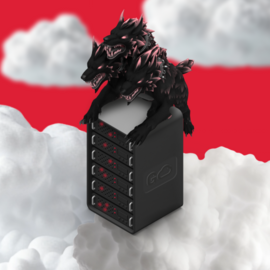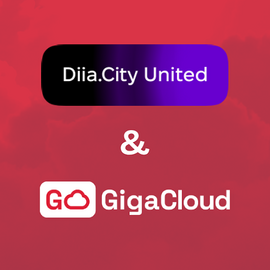Cloud DRaaS solution: features, benefits and implementation
23.06.2021
At the beginning of the 20th century, large-scale maritime disasters led to the development of special requirements for providing ships with rescue equipment: boats, rafts, life vestі, etc. Thanks to this, 712 passengers of the Titanic were able to survive.
Business also faces various force majeure quite often. And what if you draw up an action plan for business based on the principle of ship rescue? DRaaS will be the lifeboat for the company in such a case. Read below about what this service is, how it is implemented and what advantages it provides.
What is DRaaS
DRaaS (Disaster Recovery as a Service) is a cloud service for emergency recovery of IT infrastructure at a backup site which is located at the facilities of a cloud operator. Its purpose is to ensure uninterrupted operation of the client's critical IT services.
Redundant systems are used in many systems and mechanisms, for example, in aircraft. In the event of a malfunction of the main system, the backup performs its functions independently. Switching takes place instantly and synchronously.
The number of force majeure events affecting business continuity has increased in these latter days. Hurricanes, floods, fires, earthquakes, equipment failure and power outages, cyber attacks are a serious threat to any company. For example, the data centre of the OVH cloud operator burned down in March 2021.

How the disaster recovery service works
The client creates a replicas of its virtual servers on the operator's platform, and they ensure the operation of critical services. They are created at a given frequency, which depends on the amount of data added to the virtual servers and the client's requirements. That is, the client's infrastructure works in one cloud and after a certain period of time is copied to another. But if the client's main platform becomes partially or completely inaccessible, then the backup infrastructure is put into operation.
RPO (Recovery point objective) is a point in time in the past to which data is restored. The value of RPO determines the possible loss of data, it is chosen by the client. Two following factors are taken into account: the permissible amount of data loss and the amount of data that will be transferred during copying (replication). There are situations where the replication process cannot be completed in 15 minutes due to the large amount of data. In this case, you need to increase the bandwidth used for replication or increase the RPO value.
RTO (Recovery time objective) is the time allocated for data recovery, i.e. the allowable idle time. If we assume RPO = 15 and RTO = 10, then the maximum possible data loss will be 15 minutes, and the data will be restored within 10 minutes.
There are two ways to implement the disaster recovery service: using the software solution Veeam Cloud Connect and vCloud Availability.
Veeam Cloud Connect is a software solution that helps to configure replication to the service provider’s cloud and switch to replicas in case of an accident at the main platform. This software solution will allow you to implement Disaster Recovery for infrastructure that is both in the cloud and on the hardware.
The vCloud Availability solution is based on VMware technologies and is suitable only for virtual infrastructures built on this virtualisation platform. It enables customers to independently replicate their virtual machines between different facilities, as well as create backup copies of infrastructures.
The difference between DRaaS and BaaS
DRaaS is not backup, although it uses a very similar technology. Let's see what the difference is.
Data copying. Backup and replication perform different functions. Backups serve exclusively to save data and have the form of files with a copy of information on the disk. A replica is a clone of a VM that is ready to run. The replica, in addition to the information on the disk, contains data about the configuration of the VM and the applications installed on it. The replica is not compressed or encrypted. This results in a shorter RTO. The frequency of synchronization of the replica with the source VM is set by the client. The minimum synchronization time is 5 minutes, the maximum is once a day.
Data recovery speed. Unlike a backup service, DRaaS provides a faster data recovery rate in the event of a failure. If data recovery takes several hours or days when using backup, then disaster recovery will allow you to resume work after only 5-20 minutes.
Flexible configuration of the disaster recovery plan. You can restore all virtual machines of the company with the help of DRaaS. Individual files are restored by the BaaS service. A disaster recovery service can provide a configured and activated cloud infrastructure in minutes. Applications hosted on the failed servers will be up and running instantly. Of course, if the data was replicated to the operator's cloud.
The main difference between DRaaS and BaaS is that these services have different purposes. The first is for disaster recovery, the second is for data protection. DRaaS also protects data, and in addition, the targeted IT systems. But using it solely as an alternative to BaaS would be inappropriate.

Why businesses need DRaaS
Just one minute of downtime can cost a company millions in losses. And if the business does not work for more than a few days, the company is threatened with complete closure.
Let's imagine that the site of an on-line store of lighting equipment gets down. At the same time, suppose the store earns 5,000,000 hryvnias per year. We divide this amount by 525,600 (the number of minutes in a year) and get approximately UAH 9.5. The store earns this amount every minute. If the store uses the DRaaS service, it will resume work in 10 minutes, and the losses will reach only UAH 95. And if the store did not have an emergency recovery service, then the losses could be counted in tens of thousands.
By placing its IT services in the cloud, the client can get a backup platform, which, in the event of force majeure, can turn on at any time and continue to work quietly. For example, the GigaCloud cloud operator will be able to deploy it on servers located both in Ukraine and in Europe.
After the NotPetya virus attack, Porsche Ukraine began looking for fault-tolerant solutions and infrastructure insurance options. The company rented infrastructure from GigaCloud and built a cloud DRaaS cloud solution. Now, in case of any accident, the business does not stop, and all services continue to work in the cloud.

Why it is better to entrust disaster recovery to a cloud operator
Everyone must do their job. Building a backup platform is the task of the cloud operator. And here's why.
Deploying and managing your own disaster recovery infrastructure entails a number of costs: purchase of servers and network equipment, allocation of a special room for their storage, payment of electricity, cooling and work of technical specialists. In addition, you need to take care of programs for creating backups and licenses for servers and storage. The cloud operator already has all this.
Ready-made DRaaS cloud solution provided by the operator reduces the deployment time of the backup platform from several months to a few hours. The amount of time depends on the number of servers that need to be connected to the cloud disaster recovery system. In addition, during the self-deployment of the disaster recovery system, it is possible to protect only the most important servers in the first place.
When ordering a DRaaS service from a cloud operator, you can be sure that it assumes all the responsibility for the operation of the backup platform and the implementation of the recovery process. Any DRaaS solution scales as the company grows.
Secure data storage is a top priority for a company of any size. The GigaCloud cloud operator complies with the following necessary norms and security standards: Comprehensive information protection system (CIPS), ISO 27001 and PCI DSS. This gives customers confidence that the recovery will be done correctly.






